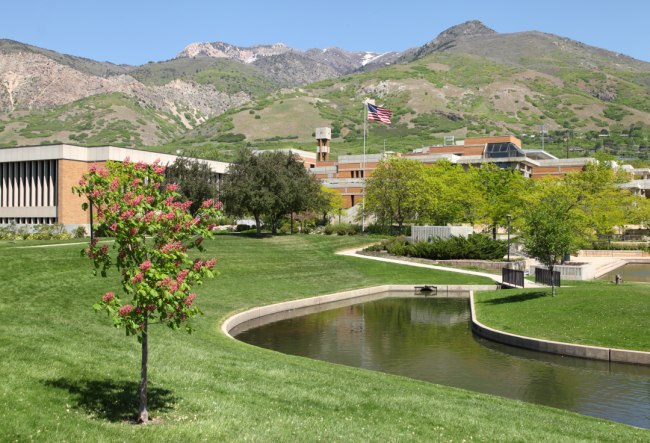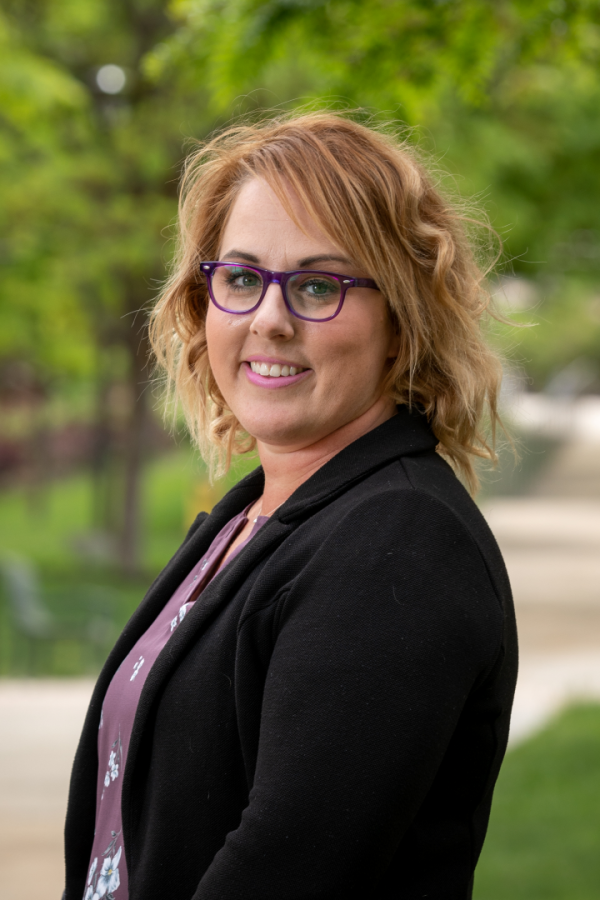You have /5 articles left.
Sign up for a free account or log in.

As vice president of student access and success, Oyler is responsible for promoting unity across her division in connecting students to resources and information.
DenisTangneyJr/Getty Images
Following a divisional restructuring, Weber State University in Utah appointed Jessica Oyler to serve as the first vice president of student access and success.

Jessica Oyler, Weber State University's inaugural vice president of student access and success
Weber State University
Oyler previously served as the associate provost of enrollment management and student success. In her new role, she will align traditional enrollment management areas with student affairs offices. Oyler began her tenure in the new role on June 1.
She spoke with Inside Higher Ed about the transition, her strategies as a leader during restructuring and her goals in the first year.
Q: What led you to a career in higher education?
A: My undergrad was in agricultural education, and I got to student teaching and realized that maybe high school was not where I wanted to be. But I had been a resident assistant at the University of Arkansas, and so I was like, “OK, I’m gonna go ahead and finish this degree … and then I’ll go to grad school.”
So I looked for grad schools that were still accepting folks that had student affairs postsecondary educational leadership types of [programs], went out to San Diego State; my mentor there worked with assessment in student affairs—which was relatively still new at the time. And then I moved to Weber State for the job.
I started as an assessment coordinator here 15 years ago and have had all kinds of different roles since then. I started with that, with assessment and strategic planning, picked up some different reporting areas. During COVID, I was the assistant vice president for human resources; they gave me that as an interim role, and then I took that on.
About a year and a half ago, I started as the associate provost for enrollment management and student success after our vice president for student affairs moved on. They were like, “We need to really focus in on what we’re doing with student success and removing barriers for students over all.” So they merged Enrollment and Student Affairs—most of what was in both of those areas—together for this new division. But coming back to this position is like coming back home [to] where my original grad school work was from.
Q: What was the institutional realignment and why was that a priority for the administration?
A: With Enrollment being in Academic Affairs and Student Affairs running a lot of the co-curricular services, there were some separations that were there just physically because of the boundary lines between the two divisions.
We rolled out a new four-year scholarship model a few years ago, and the communication lines really broke down between those division lines. So when we were looking at student feedback, and [during] COVID, we started doing student check-in surveys every few months. Looking at feedback, we’re seeing all kinds of places where that communication breakdown was occurring.
A lot of these barriers or division lines we’ve put in place for ourselves, and they don’t make sense to students. We want to look at, really, organizing how can we put our system together so it makes sense for students? So yesterday, we had our back-to-school luncheon, and somebody was asking why we were doing this, and how can we find out more about what other services are doing? I said, our end goal with this realignment is that you don’t have to know where to send people, that it just makes sense.
That’s somewhere where institutional knowledge and being here made a huge difference. We have close to 20 departments and 220 employees within our division. Over the last two and a half months, we’ve identified our mission and vision and goals. And just last week, I rolled out to the division a new org chart.
Q: Institutional departments are infamous for working in silos. How do you regroup effectively and efficiently?
A: That came up a lot during our reorg—people were like, “Well, we still want to be identified as Academic Affairs” or “We still want to be identified as this.” And what’s fascinating is so much of your perspective on that is based on who was your mentor at some point and how it was aligned to the institution that you grew up with. So many different professional organizations out there like NASPA and ACPA have a lot of enrollment professionals, but here at our institution, they were like, “Well, enrollment is AACRAO.” Just such different perspectives.
Part of it is just having conversations. The moment that I was picked for this position, I sent out a survey to everybody in the division asking, “How do you feel? What are your concerns? How are some ways that we can align things?” We had a town hall that week where we came together, we had a couple of retreats. So, really, I haven’t slept in two and a half months, if we really want to get down to it. But just listening to what those concerns are and addressing them head on.
Yesterday, we had our back-to-school luncheon; today, we just had a division open conversation where anybody could come and talk about whatever they want to. Some of it was talking about, what feedback did I take into consideration when we put the org chart together? But then we also talked about what are different things we want to do with commencement to increase student engagement.
Part of it is asking for that feedback. The other part I think that’s important is setting expectations for folks. One of the things I acknowledged was we had an interim for about nine months here with our student affairs VP. Acknowledging that a lot of change occurred and these are some of the feelings that are out there, and this is why we’re doing the org chart and mixing things up. Part of it was to challenge our own perspectives, but the other thing was to really look at what aligns for students.
But being transparent with all of it is what’s been key to me there. And then I think it’s important that the goals that we came up with are representative of both perspectives of what was enrollment or what was student affairs. It’s been super fun.
Q: How do you hope the new alignment changes the student experience at Weber State?
A: The name of our division is Student Access and Success, which is really not a common one out there at all. But when our president put the division together, he asked faculty and staff and students for feedback about what they thought it should be, and this is where we landed.
My goal is that, when students are interacting with the different offices, that they’re not getting bounced around to other offices. That if they reach out and they ask a question, that we’re helping no matter where we are within the division, getting them connected to all of the resources at once. Not overstepping our expertise, but not expecting our students to have that capital, especially as an open access institution.
My goal would be to organize things where they make sense, but also students generally don’t care about how we’re organized, right? They just care that we’re all representatives of the organization. And so my goal is for them to come to anybody within the organization to be able to get their questions answered.
Q: And how do you do that?
A: We’re looking at all kinds of things right now, with students success coaches, and certainly that is stressing some folks out where they’re like, “You expect us to know everything?!” And I was like, “No, but I do expect, as people who work here, that we have a general idea of what everybody else is doing.” But when I figure it out, I’m gonna sell it to everybody else.
Q: You’ve mentioned quite a few goals, but what are you targeting for this first year?
A: Gosh, to get through this reorganization and share that out is a big one. Definitely enrollment-related targets. Right now, I’m pretty excited for where we’re trending for fall. As a regional institution, we have seen enrollment declines over the last few years, and we have record admission rates this year; we have record retention, we had gains in completion. So definitely looking at those metrics, because I feel like we’re at a really good place as an institution.
I think that streamlining services is only going to improve that. But one of the things that I’ve continually talked to folks about is, like, if we’re organized in a way that is preventing us from moving student success forward, I’m not going to be committed to it—we’re gonna make some adjustments. So looking at some of these feelings of the check-in surveys and how students are doing and how they feel that they’re getting connected.
With some of the work we’ve done for the past few years, I can feel the culture on campus shifting to really be more focused with the student in mind. I think everybody has been, just what that looks like is different. Looking at enrollment rates is going to be one of the biggest indicators, but also student satisfaction. But I think one of the most important things to look at a year from now is how our own division staff feels going through a reorganization, having an interim and then me realigning things again, to check in with them and say, “How are we doing? And do you think that this is helping?” is going to be a pretty big metric for me, too.
Seeking stories from campus leaders, faculty members and staff for our Student Success focus. Share here.




